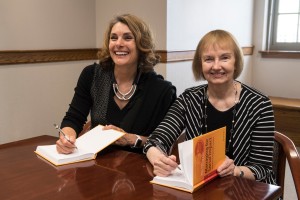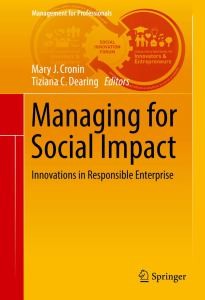
Dearing (left) and Cronin signed copies of their book during a recent symposium at Boston College entitled Leading for Social Impact.
Professor of Macro Practice Tiziana Dearing has teamed with Carroll School of Management Professor Mary Cronin to edit an innovative book designed to provide a paradigm for “socially responsible enterprise management” for those in the fields of academia, social work, nonprofit, government, and business alike.
The book, called Managing for Social Impact and available through Springer Press, debuted as an Amazon #1 New Release in business ethics. It includes contributed chapters from 22 individuals representing organizations as diverse as the Environmental Defense Fund, local community champion Haley House, public relations giant VOX Global, and Northeast burger stalwart b.good.
Throughout the course of the project of collecting and editing the content for the book, Dearing and Cronin developed a framework to elucidate recurring patterns that they noticed in the contributors’ work; patterns that they believe could go a long way in scaling up impact, across disciplines. From those patterns Four Pillars of Sustainable Social Impact emerged, namely: Open Circles, Focused Purpose Sharing, Mutuality of Successes, and Persistent Change Perspective.
For an in-depth dive into this novel way of what Dearing calls “deep pattern thinking,” we of course encourage everyone to pick up a copy of the book. To further whet your appetite, though, read the Q&A below with Professor Dearing, where she discusses the process of working with co-editor Cronin, some of the main ideas and impetuses behind the book, and what it means to her to contribute to a conversation intent on increasing the social impact that we all can have, especially when working together for the greater good.
Congratulations on the book, and its initial success. Tell us about its origins.
Tiziana Dearing: Thank you! We’re very excited about the early response to the book, and look forward to being able to share its messages as widely as we can.
I initially met Mary as a member of the School of Social Work’s Council on Innovation, and soon after, we began getting to know each other. At this time, Mary was working with Professor Ken Himes to develop an interdisciplinary minor between the Carroll School and the Morrissey College for Arts and Sciences on managing for social impact for the public good. Over coffee, Mary mentioned to me that, as they were developing the coursework for this new minor, she was unable to find a text at the intersection of social justice and managing for sustainable impact. Mary thought there was a book missing in both the business and academic marketplaces, and she asked me if I agreed that wouldn’t it be fun if we did something together.
I was a punk kid in the early 90s just setting out on a career in management consulting when Mary came out with her first book, Doing Business on the Internet, and it was a book that anyone in our field that was serious absolutely read. And now, a couple of decades later, here she was offering me the opportunity to work with her on a book that, by the way, combined my two favorite things, which is social justice and how do you make change stick. Of course I was going to say yes to that!
Honestly, along with Cronin and Himes, other changemakers at Boston College including Stephanie Berzin and Marcie Pitt-Catsouphes created an environment that allowed me to have the opportunity to be a part of something like this incredible book. I am just lucky to be here.

Let’s get into the nuts and bolts of the book itself a little bit. Managing for Social Impact lists 22 contributors to 13 chapters, and there are individuals from a variety of sectors. How did you go about compiling the list of impressive people who you wanted to be a part of this project?
TD: This was a fun part of the process. We started with some basic ideas about the kind of scope and range we knew we wanted — from super local to global, and across all the sectors — for-profit, nonprofit, philanthropic, government, and multi-sector collaborations.
One of the things I’ve been saying for years is that I believe Boston is America’s civic incubator, and while we wanted to attract authors who live and work in places all over the world, we had a really robust place to start, locally. We began by reaching out to organizations and companies that Mary has become aware of in her previous research, as well as my fairly substantial network of social entrepreneurs and innovators. We had very few people who said no, and in fact, I just heard from someone who had to say no, and who wished she had been able to say yes now that she’s seen the book. The breadth of the viewpoints represented in this book is a testament to what happens when you can work collaboratively across disciplines. She has one set of networks that she brought to the table; I have another.
Talk about your process of working together as co-editors.
TD: Some authors in this book are writers, and some aren’t. For those experienced writers, the editing process was pretty straightforward. For others, who are so deeply engaged in the work they do on the ground that maybe they haven’t had the experience of publishing articles, it can be a much more high touch process. And for still others, we simply benefited greatly from being considered as a venue for publishing trailblazing work. I’m thinking especially of Urban Catalyst’s Michael Gilligan, who, in our book, presents arguably the first thoughtful and systematic look at the ways late stage private equity can affect impact investing.
Your introductory chapters to Managing for Social Impact present a new paradigm for scaling up impact across disciplines. Tell us how you came together to build these nascent Four Pillars of Sustainable Social Impact.
TD: Absolutely. Originally, we hadn’t planned on writing an introductory chapter. But throughout the editorial process, it became clear to both Mary and me that there were recurring patterns in the submitted material that couldn’t be ignored, and patterns we were recognizing across a broader set of actors in this arena. At the same time, we were having conversations about material that was missing in the marketplace, and the opportunity that presented to address some of these that were, until now, rather glaring omissions.
Eventually, Mary suggested to me that we needed to address the patterns we were seeing in an introductory chapter, and that I should write it, and she would edit it (I needed a very hands-on edit from Mary, who came up with the names of all the pillars, by the way). It turns out that you can look all the way from up and down, global to hyper-local, and all the way across, government to for-profit, etc., and in fact, if you look closely and really pay attention, there are a set of best practices emerging. You have to look hard to see them — because in every industry and scale they are called different things and enacted in different ways — but they’re there.
Mary really pushed to make sure that, no matter what sector we were discussing, and at what scale, as we talked about those patterns that there was a heavy emphasis on the decisions you have to make to manage for the scale of the problem so that that change sticks. And I pushed to emphasize the need to do the work in a way so that those experiencing the problem value the change as much as the parties working on it.
Give us a short introduction, if you would, to the Four Pillars themselves.
TD: The four pillars move across stakeholders, goal setting, strategy, and time horizon. They are, namely: Open Circles, Focused Purpose Sharing, Mutuality of Successes, and Persistent Change Perspective.
An important point I think we need to make about our intellectual contribution with this framework is that it is not some magical new idea that the world has never seen before, but instead, it is deep pattern recognition.
Do you remember in the 1990s, there were those abstract pictures that were all the rage, that if you stared at them long enough, or crossed your eyes just right, you’d see a Tyrannosaurus Rex or something? I would argue that, what we’ve done in this book, is to look at the picture right. To be able to see what was going on underneath, and draw it out. It’s exciting that, already, we’ve begun to hear from practitioners that no one has ever drawn it out for them like this, and that, even in their own work, they’re beginning to be able to see things with a new, enlightening lens. In fact, one of the practitioners that contributed to the book mentioned to me last week that they recognized that one of the pillars is the one thing that they didn’t do right in their own organization, and if they had, they might have been able to avoid some of their mistakes. It’s meaningful to know that our work might be able to help this incredible organization, and others like it, as we move forward, together.
Expand a bit more on your hopes for the impact of this book.
TD: One of the great things about the fact that this was truly a multidisciplinary project is that there are various markets that we believe we can begin to penetrate. We both care very much about teaching, for example, and Mary needed this project for a rapidly growing and popular interdisciplinary concentration at Boston College that is influencing many of our undergrads about how they will pursue their own futures. If the book went nowhere else, I think we’d both feel like that was pretty good work.
An area that I’m particularly interested in bringing the book into is the philanthropic sector, because how money is invested or not becomes such a rate-limiting factor for what change is possible. There are cutting edge philanthropists and philanthropic agencies out there that I think get this, and could be driven even further with the support of this material, but there also philanthropies who are nowhere near this yet. If we could convince these individuals and organizations to use their capital in ways that specifically support these kinds of approaches, I believe we could really scale up impact.
We also both believe there is a huge opportunity in the corporate sector. Bridget Akinc’s chapter on transformation through social impact at the Whirpool Corporation is a fascinating study to this end that I would highly recommend.
Thanks so much for your time Professor Dearing. Any final remarks you’d like to add before we let you go?
TD: I have to say, it was a complete joy to work with Mary. She has been the easiest colleague to work with on a most fruitful project. I’d like to thank her for adding a new component to my career. I am most grateful to her.

